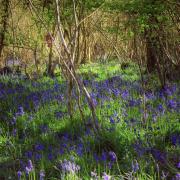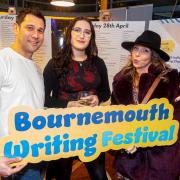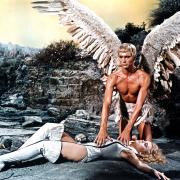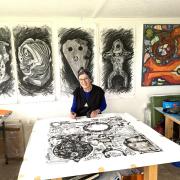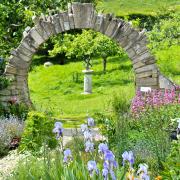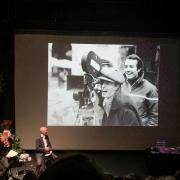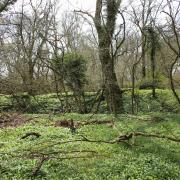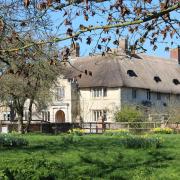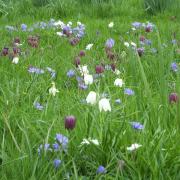When does craft become art? Stephen Swann thinks he may have found the answer
I arrive at the workshop of Stoneform near Bockhampton just as Zoë Cull is about to begin cutting letters into £300-worth of beautiful green Cumbrian slate. She will be using hand tools little changed since the days of the medieval masons who worked on England's cathedrals. Attacking such an expensive piece of stone with a hammer and chisel seems to me a bit like driving a new car at speed down an ice-bound hill - one false move and you could be in for a hit on the bank account.
I put it to Zoë that letter cutting must be a somewhat nerve-wracking craft. She grins. "It's bloody scary! There is no going back with stone," comes her reply. "I cocked up some dates once. It was a hard-won lesson."
Nor does Zoë just cut the letters. They are of her own design, they have to be because letters cut in stone look completely different from printed letters because of the role played by light and shade. Here's Zoë again: "I don't carve type fonts as the spacing and proportions don't work in stone. Most letter cutters devise their own fonts. Some use calligraphy, but I prefer to draw in outline."
Letter cutting is just one of the skills Zoë is trained in. On the morning I arrived she could equally have been carving a baptismal font, a knot bench, a fireplace, an architectural detail, a garden feature or a sculptural piece. In fact, it is no exaggeration to say that if it is possible to carve something from stone, Zoë and her colleague and partner, Alex Evans, are up for it.
Zoë did not begin her working life as a stone carver. Born in London to parents who were both designers (her dad was a graphic designer and her mum an interior designer), Zoë has a degree in graphic design from Middlesex Poly.
"I worked for the John Lewis Partnership doing their internal magazines. I did PR work and sort of muddled along," she says. "My heart wasn't in it though. I'd always known that I wanted to be an artist. Even as a child I drew a lot and somehow my drawings were always about making things look three-dimensional when other kids were hooked on pattern and colour.
"I've always loved architecture, particularly architectural detail, so when I finally got into stone carving it was a coming together of several different strands. I made the switch at the age of 30. In 2000 I went to Weymouth College to retrain as a stone carver. The college offered an HND course in Architectural Stonework and Conservation, for which it is held in high regard by those in the field.
"Working with stone was where I wanted to be. I love the stuff. You develop a feel for it. Different types of stone have different qualities and you have to be aware of them and choose stone suitable for the purpose you have in mind."
Zoë and Alex went into business in 2003. "It was a struggle to make ends meet at first," Zoë tells me. "Even now I earn much less than I did working in London 10 years ago. Our first real job was doing coping stones for a house in Beaminster. We worked in a garage. We did small lettering jobs, house names mainly, and then we gained a commission to make a baptismal font for the church of St Anthony of Padua in Radlett. I see myself as a designer as well as a stone carver and to be allowed to come up with something like that was fantastic."
She is, however, reluctant to call herself an artist. "I am a craftsman and designer rather than an artist," she insists. "I solve particular problems for a specific commission, looking at the use to which an object is to be put and how it will co-exist with its surroundings. All this brings out my creative best."
Certainly. But look at that font. It is in hard white Ancaster limestone and takes the form of an upheld bowl overflowing with water, its tri-lobed stem is a reference to the Holy Trinity, its Cumbrian green-slate base symbolises a pool, whilst its incised biblical inscription, in letter forms inspired by Hebrew calligraphy, has been cut to look distorted, as if viewed through water. Looking at it, it seems to me that Zoë has crossed that ill-defined line that separates the craftsman/designer from the artist. Look too, at her Knot Bench. It's a seat. It is also a kind of visual paradox, something that poses questions about the way we see the world. The stone seems to have been twisted into shape as if it were warm toffee. It is stone made to look flexible.
Our conversation returns to letter cutting, something it is obvious that Zoë is passionate about. "I find letter cutting one of the most challenging parts of my work. Compared to architectural carving, which is all about knowing your geometry and following a formula, letter cutting is much more involved, requires great attention to detail and a self-critical approach. For small inscriptions I draw the words on the stone directly - it's fresher, more immediate - whilst on larger lettering pieces I will set the words out on paper. It has taken me years to get where I am now and I'm learning all the while. In many ways every job is a new beginning."
I ask if she had to choose a single letter-cutter whose work she most admired, who would she go for? "Reynolds Stone," she replies unhesitatingly. "I love his work and, of course, he lived here in Dorset."
I end our chat by asking Zoë where she would like to be in five years' time. She laughs. "Working less hard and earning a bit more money! At the moment both Alex and myself work seven days a week. It might not be actual stone carving, it could be doing admin, packing pieces up, delivering or working up ideas. I'd like more time in my garden and in the kitchen - I'm really into cooking. And in five years I would like to have the time to get involved with more public art projects."
Well, only time will tell, of course. For now, though, it is not being too fanciful to say that for Zoë Cull the future will surely be written in stone.
See more of Zoë's work at www.stoneformdesign.co.uk.
Quotes
"Different types of stone have different qualities and you have to be aware of them and choose stone suitable for the purpose you have in mind"
I find letter cutting one of the most challenging parts of my work



